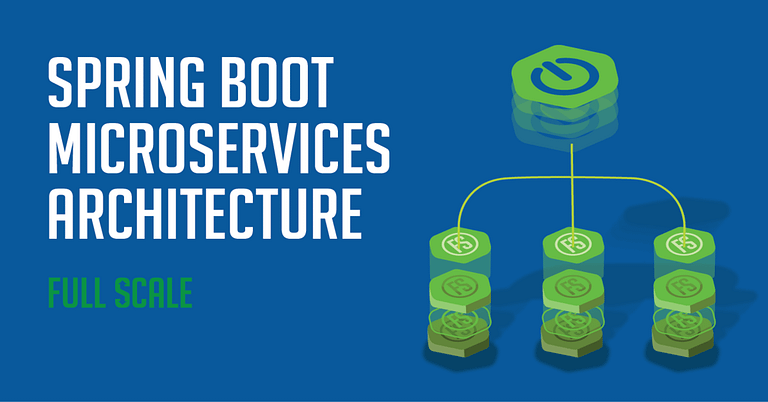Last Updated on 2024-10-11
Have you used shared databases for Spring Boot microservices? If not, then it might be a good idea to try now. Read on to learn more about the benefits of using Spring Boot microservices for your system.
You might be familiar with Netflix. This company was originally a DVD-by-mail service which has now transformed into a popular streaming service since 2007. How were they able to manage a whole lot of content and distribute it seamlessly? The answer is microservices.
A microservice is a software architecture approach that focuses on decomposing applications into single-function modules. Well-defined interfaces are independently deployed and operated by small teams who own the entire service lifecycle.
Microservices help software teams create micro applications that function independently. This helps keep the team efficient and consistent in delivering work since they assemble parts of the whole system. All they have to do is merge all the services to create the complete functionality of the app. How do they do that?
Building Microservices
Building microservices allow you to minimize the risk of change. By reducing communication requests, microservices architecture helps accelerate the delivery of the software application.
Each microservice handles one function, implements commands for UX, logic, and creates the connection to the database. Microservices help build different functions that interact with each other. One function could be uploading photos, and you make another for creating a new account. Both share the same database.
Now that we understand the concept of creating microservices, how do you build them in the most efficient way possible?
Spring vs Spring Boot: How to create microservices
Spring has been used to develop many enterprise-level applications. Over time, Spring has developed to become more complex to use. With it came the inception of Spring Boot microservices. But before we dive into the benefits of using shared databases, we need to understand the concept of Spring first.
Spring framework is an open-source and comprehensive programming platform for Java-based applications. This works on any deployment platform. Spring is known to be popular for software development, especially in developing any enterprise Java applications.
However, Spring Boot is built on top of the Spring framework. As the Spring framework is becoming more complex, Spring Boot was created to simplify the development process and reduce the code length. Some of the features of using Spring Boot include:
- Creating stand-alone Spring apps
- Helping simplify build configuration
- Configuring Spring and any third-party library automatically
- Providing production-ready features like health checks, externalized configuration, and metrics.
- Zero code generation and requirement for XML configuration.
Spring Boot microservices provide all of Spring’s features without the complexity. You can configure it automatically by utilizing a particular function. This extension of Spring makes development to deployment more convenient.
So how do you integrate the use of Spring Boot microservices into shared databases? With that, you need to use Spring Cloud.
Spring Cloud provides a group of features that quickly build microservices. Using Spring Cloud with Spring boot will allow you to rapidly set up microservices with very few configurations.
Spring Boot Microservices with Shared Databases
Usually, microservices use a decentralized database approach. This means that each of the Spring Boot microservice you create has its database. Martin Fowler suggests that if you want to use microservices, you must build it that way. So what should you do?
Creating spring boot microservices doesn’t have to have independent databases. In most cases, functionalities will have to share data at some point. One example would be microservices for an online store.
In e-commerce servicing, you handle billing and authentication services that will need access to user data. With a shared database, you no longer need to duplicate the data you have. You just need to have your microservices communicate with each other effectively.
Let’s go back to our initial example, Netflix. The app needs to deliver media in various forms, including images, audio, video, and subtitles. Netflix uses microservices to call on all required data. They use microservices where they have a media database.
The microservices architecture will power all the APIs needed to run, including the web apps. Sharing data between microservices will help increase availability, reliability, and performance.
Creating Shared Databases with Spring Cloud
Let’s illustrate further how you can create shared databases using the Spring Cloud function.
For example, you have groups of microservices that use different databases. Group A uses a MySQL database, while Group B uses MongoDB. You will then be using services that will connect the databases of both groups. There are available gateway services that act as messengers from one database to another. Through these gateways, you’ll be able to receive requests and forward them to their intended service.
The Spring Cloud acts as a central database that handles configurations between databases and microservices. In essence, Spring Cloud stores the configuration data for all microservices. It streamlines the requests and responses so they’re correctly delegated.
Once configuration data from each node is stored and saved, you can keep the communication between Groups A and B through their respective databases.
Some software teams may write their code in different languages. Since developers can independently work on microservices, there might be instances where they need to integrate with other services. One way to handle this is to create a shared communication system through shared databases.
Sharing Data between Microservices
Using a shared database helps keep the low maintainability of the program. By creating a communication system between microservices, it’s easier to retrieve data. Also, you don’t have to go into each microservice and make changes.
When you are writing the library project for the database, you need to keep these things in mind:
- Make your libraries cohesive and make sure that they only function as to how they are supposed to.
- Your library should be lowly coupled. Avoid having too many dependencies on modules. They must require only a few dependencies as much as possible.
The application should be able to function without depending too much on the other services, vice versa. You just need to make sure that only necessary application requests can access their intended purpose without having many dependencies.
In essence, using libraries will help you save time and effort, especially when building Spring Boot microservices. Spring Boot has ready-to-use libraries set in place that you can take advantage of.
Why Use Spring Boot Microservices
One can’t just decide to use Spring Boot microservices on the get-go. You have to give it some thought on how you will execute it. Microservices architecture just doesn’t fit anywhere. Also, just like any other framework, Spring Boot microservices has limitations that you need to address to deliver a great product. Understanding how it works is essential.
There are a lot of discussions about using Spring Boot microservices, but it all boils down to what you need. It could be that a monolithic architecture will work better for you, if not microservices. At the end of the day, whichever is more compatible with your system requirements should be the best solution.
Using Spring Boot to create microservices will help make your work easier and faster. The best part is you can configure it automatically. With this, you save more time coding and setting up unnecessary configurations.
When developing enterprise-level applications, your software developer should be able to find the best solution to data problems. Having a full-stack developer at your back will save you time, effort, and money when building these systems from scratch.
At Full Scale, we help companies build efficient systems with only the best programmers in the industry. We have a rigorous hiring process, and you can be sure that the developers you will work with are qualified to help you succeed.
Contact us to know more about improving software processes and launching your software products with ease. Let’s work together to reach your business goals.

Matt Watson is a serial tech entrepreneur who has started four companies and had a nine-figure exit. He was the founder and CTO of VinSolutions, the #1 CRM software used in today’s automotive industry. He has over twenty years of experience working as a tech CTO and building cutting-edge SaaS solutions.
As the CEO of Full Scale, he has helped over 100 tech companies build their software services and development teams. Full Scale specializes in helping tech companies grow by augmenting their in-house teams with software development talent from the Philippines.
Matt hosts Startup Hustle, a top podcast about entrepreneurship with over 6 million downloads. He has a wealth of knowledge about startups and business from his personal experience and from interviewing hundreds of other entrepreneurs.





